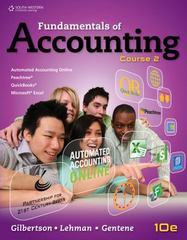Question
Question: a. Using T-accounts, what do the balances in balance sheet accounts look like on February 1, Year 13 (see Problem 2.14), and what is
Question:
a. Using T-accounts, what do the balances in balance sheet accounts look like on February 1, Year 13 (see Problem 2.14), and what is the impact of the 13 transactions .
b. what would the income statement for the month of February, Year 13 look like.
c. what would a comparative balance sheet as January 31 and February 28, Year 13 look like
Note: Refer to the information for Patterson Corporation for January, Year 13, in Problem 2.14, below.
The following transactions occur during February.
(1) February 1: The firm pays the two-year insurance premium of $2,400 for fire and liability coverage beginning February 1.
(2) February 5: Acquires merchandise costing $1,050,000. Of this amount, $1,455 is from suppliers to whom Patterson returned defective merchandise during January but for which the firm had not yet received a refund for amounts paid. Patterson Corporation acquired the remaining purchases on account.
(3) During February: Sells merchandise to customers totaling $1,500,000. Of this amount, $4,500 was to customers who had advanced Patterson Corporation cash during January. Patterson Corporation makes the remaining sales on account.
(4) During February: The cost of the goods sold in transaction (3) was $950,000.
(5) During February: Pays in cash selling and administrative expenses of $235,000.
(6) During February: Collects $1,206,000 from customer for sales previously made on account.
(7) During February: Pays $710,000 to suppliers of merchandise for purchases previously made on account.
(8) February 28: Recognizes rent expense for February.
(9) February 28: Recognizes depreciation expense of $2,500 for February. Patterson Corporation uses an Accumulated Depreciation account.
(10) February 28: Recognizes amortization expense of $450 on the patent. Patterson Corporation does not use an Accumulated Amortization account for patents; instead, it records the amortized amounts directly to the patent account.
(11) February 28: Recognizes an appropriate amount of insurance expense for February.
(12) February 28: Recognizes interest expense on the mortgage payable (see transaction (12) in Chapter 2, Problem 2.14).
(13) February 28: Recognizes income tax expense for February. The income tax rate is a. b. c. 40%. Income taxes for February are payable by April 15.
Note: Problem 2.14:
Patterson Corporation begins operations on January 1, Year 13. See the assumptions given at the end of the list. Problem 3.23 continues this problem. The firm engages in the following transactions during January: (1) Issues 15,000 shares of $10 par value common stock for $210,000 in cash. (2) Issues 28,000 shares of common stock in exchange for land, building, and equipment. The land appears at $80,000, the building at $220,000, and the equipment at $92,000 on the balance sheet. (3) Issues 2,000 shares of common stock to another firm to acquire a patent. The price per share is $14 per share. (4) Acquires merchandise inventories with a list price of $75,000 on account from suppliers. (5) Acquires equipment with a list price of $6,000. It deducts a $600 discount and pays the net amount in cash. The firm treats cash discounts as a reduction in the acquisition cost of equipment. (6) Pays freight charges of $350 for delivery of the equipment in (5). The firm treats freight charges as part of the acquisition cost of the equipment. (7) Discovers that merchandise inventories with a list price of $800 are defective and returns them to the supplier for full credit. The merchandise inventories had been purchased on accountsee (4)and no payment had been made as of the time that the goods were returned. (8) Signs a contract for the rental of a fleet of automobiles beginning February 1. Pays the $1,400 rental for February in advance. (9) Pays invoices for merchandise inventories purchased in (4) with an original list price of $60,000, after deducting a discount of 3% for prompt payment. The firm treats cash discounts as a reduction in the acquisition cost of merchandise inventories. (10) Obtains fire and liability insurance coverage from Southwest Insurance Company. The two-year policy, beginning February 1, carries a $2,400 premium that has not yet been paid. (11) Signs a contract with a customer for $20,000 of merchandise that Patterson plans to deliver in the future. The customer advances $4,500 toward the contract price. (12) Acquires a warehouse costing $60,000 on January 31. The firm makes a down pay- ment of $7,000 and assumes a 20-year, 6% mortgage for the balance. Information for later use: Interest is payable on January 31 each year. (13) Discovers that merchandise inventories with an original list price of $1,500 are defective and returns them to the supplier. This inventory was paid for in (9). The returned
merchandise inventories are the only items purchased from this particular supplier during January. A cash refund has not yet been received from the supplier. (14) On January 31, the firm purchases 6,000 shares of $10 par value common stock of the General Cereal Corporation for $95,000. This purchase is a short-term use of excess cash. The shares of General Cereal Corporation trade on the New York Stock Exchange. The following assumptions will help you resolve certain accounting uncertainties: Transactions (2) and (3) occur on the same day as transaction (1). The invoices paid in (9) are the only purchases for which suppliers made discounts available to the purchaser.
Step by Step Solution
There are 3 Steps involved in it
Step: 1

Get Instant Access to Expert-Tailored Solutions
See step-by-step solutions with expert insights and AI powered tools for academic success
Step: 2

Step: 3

Ace Your Homework with AI
Get the answers you need in no time with our AI-driven, step-by-step assistance
Get Started


